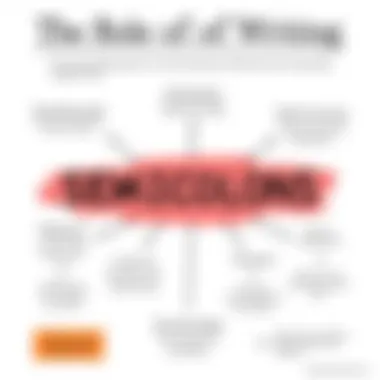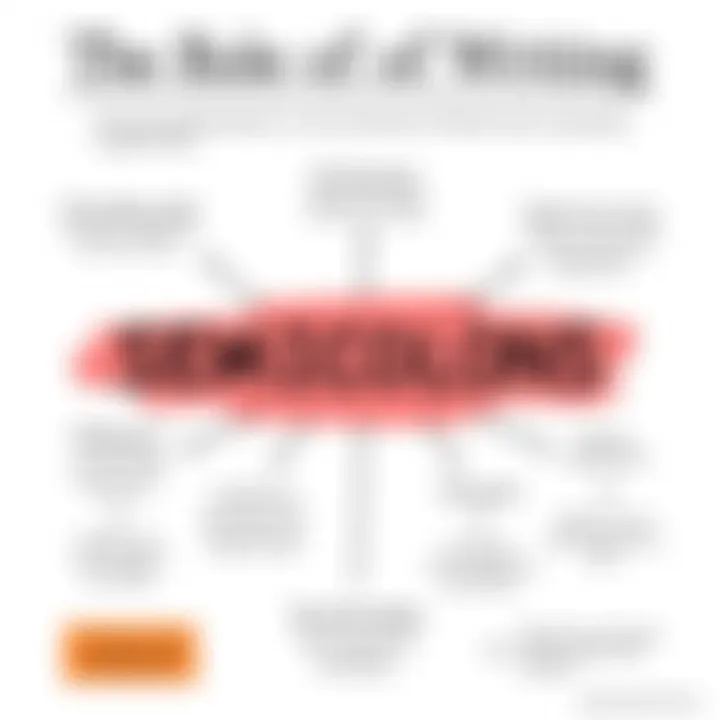Mastering Semicolons: Enhance Your Writing Skills


Intro
Semicolons, those lesser-known siblings of full stops and commas, pack quite a punch in the realm of writing. Often seen as a punctuation mark for the elite writer, their real charm lies in their versatility. Writers wield semicolons to create nuanced relationships between closely related ideas. They act as a bridge, linking thoughts and inviting readers to explore intricate connections.
Why Semicolons Matter
At first glance, the semicolon may appear daunting; however, mastering its use can significantly enhance one's writing. Unlike a period, which signals a complete stop, or a comma, which indicates a brief pause, a semicolon invites the reader into a delicate dance of clauses. It can separate two independent clauses, much like a caring teacher differentiates between two complex concepts in a classroom. The semicolon not only clarifies but also adds rhythm to prose, fostering an engaging reading experience.
"A semicolon is a pause where one thought ends and another begins, opening the door for a conversation between them."
The Semicolon in Action
Consider this example: "I have a big exam tomorrow; I can’t go out tonight." Here, the semicolon does more than merely separate two thoughts; it illustrates the relationship between the procrastination of a good time and the looming responsibility of studying. When used skillfully, semicolons can help writers convey complex ideas with elegance and precision.
The Common Misunderstandings
Many folks steer clear of semicolons due to misconceptions about their usage. The fear of missteps often leads to avoidance, resulting in dry writing. However, it's essential to understand that an incorrect semicolon usage doesn't render a piece of writing utterly flawed. Instead, it provides an opportunity for growth and learning. By demystifying semicolons and integrating them into writing practice, one can enhance both clarity and expressiveness.
The Journey Ahead
This article aims to shed light on the multifaceted nature of semicolons. From their fundamental functions to common pitfalls, each section will dive deeper into how semicolons can elevate communication. We will explore practical applications, tackling real-world examples, and share tips that will transform how writers think about punctuation. So, buckle up as we embark on this exploration of a punctuation mark that offers far more than meets the eye.
Preface to Semicolons
Semicolons often play a quiet yet pivotal role in writing, acting as a bridge between ideas. They are not merely a punctuation mark; they are a signal to the reader that the relationship between the two clauses is deeper than a period would suggest. Understanding semicolons is essential for anyone looking to enhance their writing skills or tackle complex thoughts with clarity. This section serves as a launching pad into the nuances of semicolon usage, revealing how they can transform mundane prose into something more sophisticated.
Definition of Semicolon
A semicolon (;) is a punctuation mark that sits between a comma and a full stop, yet it possesses unique capabilities. Simply put, it serves two primary functions: it connects closely related independent clauses and organizes items in a complex list. For example, in the sentence, "I have a big test tomorrow; I can’t go out tonight," the semicolon links two independent thoughts that are related. It signifies that the second clause is a consequence of the first without resorting to a conjunction or turning the sentence into a run-on.
Historical Context
The journey of the semicolon stretches back to the late 15th century, attributed mainly to the Venetian printer Aldus Manutius. In an age when language was still evolving, the semicolon was born out of necessity. Writers were seeking a way to express complex relationships between ideas without cluttering their text with too many conjunctions. As time progressed, the semicolon found its place in various literary styles, from formal writings to the more casual notes of everyday communication. Reflecting on its historical significance, one can see how the semicolon has become a symbol of precise expression in an age when clear communication is paramount. Its continued use in modern writing showcases its adaptability and enduring relevance in our conversations.
The Basic Function of Semicolons
Understanding the basic function of semicolons is crucial for anyone looking to refine their writing style. This punctuation mark serves not just as a mere decorative element in a sentence, but as a powerful tool that can clarify meaning and enhance the flow of ideas. Semicolons have two main roles in writing: they connect independent clauses and separate items in complex lists. Let’s dive into these aspects to appreciate their indispensable use.
Connecting Independent Clauses
When connecting independent clauses, semicolons act like the glue, binding two related thoughts into a cohesive unit. For separation of complete sentences that are closely linked in meaning, the semicolon is your best friend. For example:
I have a big test tomorrow; I can’t go out tonight.
In this case, the semicolon shows a relationship between the two independent clauses: the obligation for studying directly impacts the action of not going out. Without the semicolon, one might mistakenly interpret these sentences as unconnected!
A common pitfall is using a comma or a period in place of a semicolon. While commas can create sentences with a jarring shift in thought, periods can make them feel disjointed. Semicolons, however, maintain the connection without sacrificing clarity. When wielded properly, they elevate the sophistication of your writing, allowing for more nuanced arguments.
Separating Items in a Complex List
Semicolons also shine when it comes to complex lists, particularly those that contain internal punctuation. Imagine you're showcasing your favorite activities:
- Taking long walks in the park;
- Reading countless books, from science fiction to biographies;
- Experimenting with new recipes that range from spicy Indian curry to classic French pastries.


In this list, the semicolon helps to distinguish between items that might otherwise be confusing due to the commas included in each one. If simply commas were used, the reader could easily lose track of the different activities. By using semicolons, you grant each component its own space, making the information clear and digestible.
As you explore the art of writing, remember that the semicolon serves not just to connect or separate ideas—it enhances clarity and strengthens your prose’s overall structure. The more you are aware of its utility, the more effective your writing will become, helping you make your thoughts shine with precision and elegance.
Incorporating semicolons effectively can transform your writing from ordinary to extraordinary. Whether you are working on academic essays, professional reports, or even creative stories, these punctuation marks offer a level of sophistication that’s hard to ignore.
For further reading on punctuation and style, you might check resources from Purdue OWL or delve into Grammarly’s insights on using punctuation to enhance clarity.
When to Use a Semicolon
Understanding when to deploy a semicolon in your writing can elevate you from a mere wordsmith to a maestro of punctuation. The semicolon performs a unique role in bookending thoughts and separating ideas, thus enhancing the complexity and nuance of your sentences. Employing semicolons correctly not only polishes your writing but also ensures that your audience grasps your message without unnecessary ambiguity.
When it comes to semicolons, timing is everything. Knowing when to use them can help you connect related thoughts smoothly and create a seamless flow in your narrative. Moreover, they serve as tools to impress upon your readers the sophistication of your thought process.
Between Related Independent Clauses
A semicolon’s primary function is to connect related independent clauses without using a conjunction. Think of independent clauses as complete thoughts that can stand alone; they express a full idea but can also relate closely to another. A well-placed semicolon here acts like a bridge, linking two ideas while maintaining their individual integrity.
Example:
"I wanted to go for a run; the rain changed my plans."
In this example, the first part stands on its own, making a clear statement, while the second does the same, but they are closely linked in sentiment. Here, instead of losing the direct connection with a conjunction or a period, the semicolon preserves the relationship while adding a touch of sophistication to the prose.
In professional and academic settings, this connection not only illustrates your competence in writing but also enriches the depth of your arguments. If you find that two sentences share a thematic thread, consider utilizing a semicolon for a more elegant and effective transition.
Before Conjunctive Adverbs
Another significant application for semicolons occurs before conjunctive adverbs such as however, therefore, moreover, and consequently. These adverbs often introduce a complete thought that expands or contrasts with the preceding independent clause. The semicolon effectively signals to the reader that a pivotal idea follows.
Example:
"The team was fully prepared for the presentation; however, technical difficulties arose unexpectedly."
In this case, the semicolon delineates the first idea from the contrasting outcome that the conjunctive adverb introduces. This not only emphasizes the shift in context but also adds depth to your writing, helping to convey the complexities of the situation more clearly.
Using a semicolon in such instances requires a steady hand. It indicates a pause, yet it is more pronounced than a comma, allowing for a stronger connection between thoughts. Therefore, employing semicolons before conjunctive adverbs aids significantly in effectively portraying the relationships between ideas that might seem disjointed otherwise.
To become adept in using semicolons, consider reading your sentences aloud. It can help you determine where you want a connection without losing the meaning or essence of each clause. Practicing these nuances can aid in creating clarity, subtlety, and rhythm in your writing, making your communication all the more effective.
Avoiding Common Errors
Understanding common errors in semicolon use is paramount for anyone looking to refine their writing. Semicolons are often misunderstood, and their misuse can dilute the clarity and precision of your text. By practicing the correct application of semicolons, writers can significantly enhance their communication, allowing their ideas to flow seamlessly while adhering to proper grammatical standards. Misuse can lead to confusion or misinterpretation, so ensuring proper utilization is truly worthwhile.
Misuse with Dependent Clauses
One of the primary pitfalls in semicolon usage arises when writers mistakenly use them with dependent clauses. A dependent clause cannot stand alone as a sentence; it needs an independent clause to complete its meaning. For example:
Incorrect: "Although it was raining; we decided to go for a walk."
In this case, the semicolon is not appropriate because "Although it was raining" is a dependent clause. Instead, a comma should be used. The correct version would be:
Correct: "Although it was raining, we decided to go for a walk."
This error highlights the necessity of understanding the functionality of clauses in sentence structure. When a dependent clause precedes an independent clause, always opt for a comma rather than a semicolon. This distinction is crucial, as it helps maintain clarity. Semicolons should chiefly connect two independent clauses that are closely related in thought, thereby fortifying the relationship between them.
Overuse in Writing
Overusing semicolons is another common error. While these punctuation marks can add sophistication to writing, too many can weigh it down and make sentences feel cumbersome. A semicolon should not be treated as a default option when a sentence feels slightly long. Consider the following example:
Incorrect: "I went to the store; I bought apples; I saw some friends; I returned home."


Each idea here could stand as an independent sentence, and forcing them together with semicolons disrupts the natural flow. This excessive use can lead to reader fatigue. Instead, a series of sentences can often convey the message more clearly:
Correct: "I went to the store. I bought apples. I saw some friends. I returned home."
This adjustment allows each action to breathe, maintaining clarity and engagement. Overusing semicolons can create a clunky reading experience, so using them judiciously ensures your writing remains dynamic.
Semicolons and Stylistic Choices
When considering the role of semicolons, it’s important to understand how they can shape not just the structure of sentences, but also the overall style of writing. Semicolons serve as a bridge between thoughts, helping to convey complex relationships in a seamless manner. By understanding how they can be used to add rhythm and clarity, writers can elevate their prose, making it not just functional, but also aesthetically engaging.
Creating Rhythm and Flow
One of the standout features of semicolons is their ability to enhance the rhythm and flow of writing. Unlike periods, which create a sense of finality, semicolons allow for a delicate balance between multiple ideas. For example, consider the sentence:
"She loves painting; her brush dances across the canvas with every stroke."
Here, the semicolon links two closely related independent clauses, creating a fluid transition that draws the reader in. The use of a semicolon generates a subtle rhythm, allowing ideas to flow into one another without the abrupt stop of a period.
In creative and formal writing, a varied rhythm can keep the reader engaged. This helps maintain a natural pace, preventing monotonous structures. Writers often experiment with the placement of semicolons to discover how they influence the overall sound of a passage.
Enhancing Clarity in Complex Sentences
In more sophisticated writing, articulating complex ideas can sometimes lead to confusion, especially when multiple clauses are involved. Semicolons can clarify these constructions by separating distinct thoughts while still linking them. For instance:
"It was a long journey across the desert; the sun scorched the earth; water was a luxury."
In this example, semicolons effectively break up the sentence, presenting each clause as a standalone idea while still maintaining an interconnected theme. This makes it easier for readers to digest the information without getting lost in a sea of commas or conjunctions.
Additionally, semicolons can assist in placing emphasis on important points within a larger narrative. When they are applied correctly, they guide the reader's attention to crucial aspects, ensuring clarity is maintained. Writers can play with this technique to punctuate significant ideas, making their work richer and much more impactful.
Ultimately, the smart use of semicolons isn’t just about joining clauses; it’s about artistry in construction and maximizing clarity in expression. By incorporating semicolons thoughtfully, writers can master the balance of rhythm and clarity, transforming their writing into a captivating experience.
Practical Applications of Semicolons
Semicolons, though often underestimated, play a crucial role in structuring sentences and conveying meaning efficiently. Understanding their applications is essential for anyone looking to polish their writing. This section focuses on the practical uses of semicolons, emphasizing their importance in both formal and creative writing. Knowing when and how to use this punctuation mark can greatly enhance clarity and rhythm, making your prose more compelling and precise.
In Formal Writing
When it comes to formal writing, semicolons serve as a bridge between closely related ideas. They can elevate the level of sophistication in business reports, academic papers, and other professional documents. For instance, in a research paper discussing environmental issues, you could write:
"Humans have a significant impact on the planet's ecosystems; they must work actively to mitigate this damage."
In this case, the semicolon effectively connects two related thoughts, highlighting the necessity of action following the acknowledgment of a problem.
Proper use of semicolons in formal writing can also aid in transitioning between complex ideas without losing the reader's attention. For example, consider a legal document outlining obligations:
- Responsibilities include: conducting monthly meetings; ensuring compliance with regulations; and maintaining accurate records.
Here, the semicolon neatly separates items that include internal commas, which might confuse readers if only commas were used.
In Creative Writing
In creative writing, semicolons often serve the purpose of enhancing the rhythm of your prose. They can add a lyrical quality to sentences, allowing the writer to convey emotions with nuance. For instance, a novelist may write:


"The dusk painted the sky in hues of purple and gold; shadows began to whisper secrets of the night."
This usage allows for a smoother flow than if separate sentences were used, encouraging readers to linger on the imagery. Semicolons also convey a sense of contemplation, inviting readers to digest connected ideas without abrupt breaks.
Moreover, when developing character dialogue, semicolons can be used to reflect a character's varied thoughts or emotions:
"I love her; she’s everything I want; but she doesn’t see me."
In this case, the semicolons reflect an internal struggle, adding depth to the character’s voice.
In summary, whether in formal documents or creative narratives, semicolons have distinct yet impactful roles. They not only improve sentence structure but also help maintain clarity while articulating complex ideas. By mastering their use, writers can elevate their textual presentation and engage their audience with greater effectiveness.
Exercises for Understanding Semicolons
Exploring the use of semicolons goes beyond mere theory; exercises designed for understanding can sharpen your writing skills significantly. Engaging in targeted practice allows students and writers to internalize the rules governing semicolon usage.
By systematically dissecting examples and practicing correct application, individuals can distinguish between appropriate and misled uses of semicolons. In this section, we focus on two primary exercises: identifying correct uses of semicolons in context, and correcting misused instances. These exercises not only bolster grammatical knowledge but enhance overall writing clarity and style.
Identifying Correct Uses
To master semicolons, one must first learn to identify when they are used correctly in sentences. Here are some examples that illustrate proper use:
- Connecting Related Independent Clauses: For instance, consider the sentence, "I’m fond of the seaside; it’s a place of peace for me." The semicolon smoothly links two independent clauses that are closely related.
- In a Complex List: When listing items that contain commas, semicolons help avoid confusion. Take this scenario, "I have traveled to Paris, France; Tokyo, Japan; and Sydney, Australia." Without semicolons, the sentence becomes muddled and difficult to decipher.
Engaging learners in exercises that showcase these examples can greatly enhance their ability to recognize correct usages in their writing. They can practice by examining sentences and marking those that effectively employ semicolons.
Correcting Misused Semicolons
Misuse of semicolons is all too common. Misunderstandings about their function often lead to errors that disrupt the flow of writing. Addressing these errors is crucial:
- Avoiding Dependent Clauses: A classic example of misuse is attaching a semicolon before a dependent clause. For example, "Although I enjoy running; I prefer swimming." This construction is incorrect because the phrase after the semicolon doesn't stand alone.
- Overuse in Writing: In the example, "I went to the market; I bought apples; I forgot my wallet; it was a long day; the sun was shining; I felt tired," the semicolon is used excessively, diminishing the strength of the writing.
To address these common pitfalls, exercises involving correction can be beneficial. Provide sentences where errors are present and encourage learners to rewrite them properly. By shifting the focus from recognition to correction, writers can solidify their understanding of effective semicolon application.
"Writing with clarity is like drawing a roadmap; it keeps your reader on the right path without losing them in the woods of confusion."
Incorporating these exercises into regular writing practice can facilitate a deeper comprehension of semicolon use, nurturing a style that is both clear and sophisticated. Educators and parents can create tailored worksheets or group activities to reinforce these skills, ensuring that semicolons become allies rather than obstacles in writing.
End
The conclusion of this article serves as a pivotal moment, underscoring the importance of understanding semicolon usage—not just as an exercise in grammar, but as a tool for effective communication. Semicolons bridge thoughts, allowing writers to connect complex ideas seamlessly without resorting to overly simplistic structures. The ability to wield a semicolon skillfully can enhance writing clarity, engage readers, and add rhythm to the flow of narratives. When writers grasp the nuances of semicolon usage, they unlock the potential to articulate their thoughts with precision and style.
In the realm of writing, whether it’s formal, creative, or academic, semicolons can act as confident separators of two related thoughts that stand on their own. This article has highlighted specific elements to consider, such as knowing when to use semicolons between independent clauses or before conjunctive adverbs. Making these distinctions elevates the sophistication of one's writing.
Furthermore, we’ve delved into common errors that plague many writers, ensuring readers are equipped to avoid pitfalls like misplacing semicolons or using them excessively. In a world saturated with messages, the clarity brought by thoughtful punctuation can set a writer apart. Utilizing semicolons effectively enhances not only the rhythmic quality of paragraphs but also ensures that complex arguments remain accessible.
With a firm understanding of these punctuation marks, writers can express intricate thoughts without the risk of oversimplifying or losing their reader’s interest.
Summary of Key Points
- Purpose of Semicolons: They serve to connect closely related independent clauses and separate items in complex lists.
- Common Mistakes: Writers often misuse semicolons with dependent clauses and can also lean too heavily on them, creating confusion rather than clarity.
- Stylistic Impact: Semicolons enhance rhythm and clarity, demonstrating a writer’s talent in handling complex sentence structures.
- Application Contexts: They are valuable tools in both formal and creative writing, leaning on their ability to juxtapose ideas that warrant a closer look.
Final Thoughts on Semicolon Usage
Semicolons should not be seen as mere punctuation marks but as strategic allies in written communication. When used effectively, they underscore a writer's command of language and respect for the reader's understanding. The importance of mastering semicolon usage goes beyond correcting grammatical errors; it empowers writers to engage their audiences in a more robust conversation. By embracing this nuanced punctuation, one can transform simple statements into engaging discourse, ultimately elevating the quality of written work. Whether drafting essays, crafting narratives, or designing speeches, integrating semicolons thoughtfully strengthens the core message and weaves a richer tapestry of language.
"The semicolon is like a bridge; it links two shores of thought, allowing readers to traverse the currents of ideas seamlessly."
For further exploration of semicolon usage, consider visiting resources like Merriam-Webster or the Purdue Online Writing Lab.















